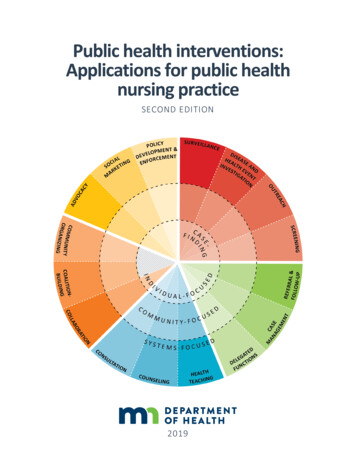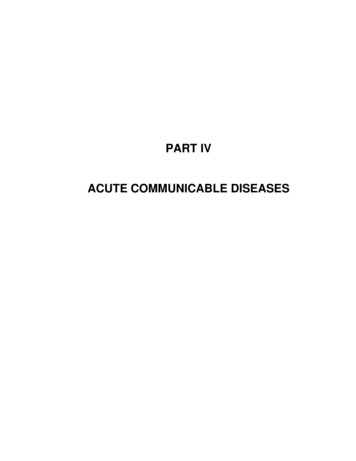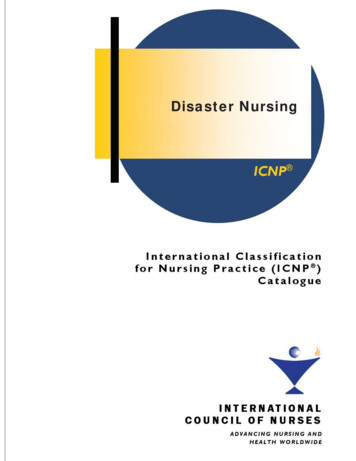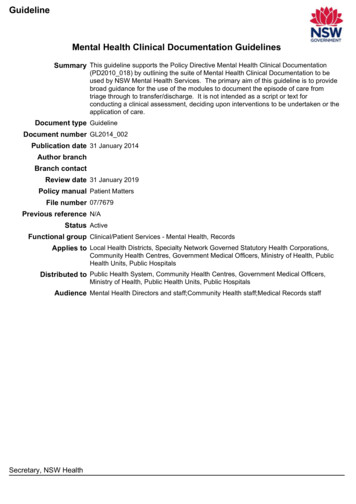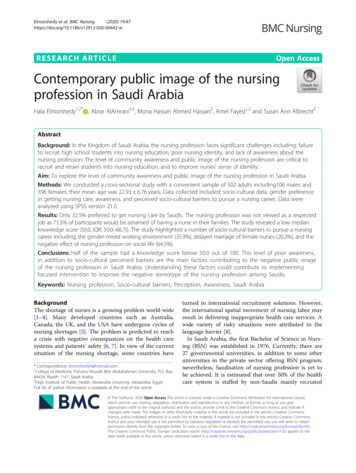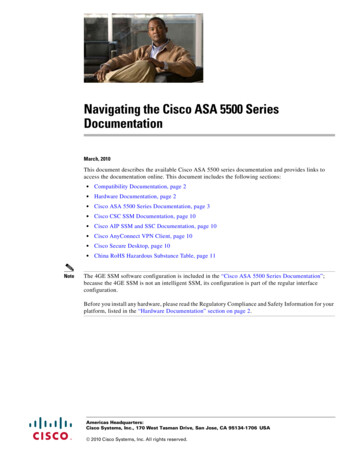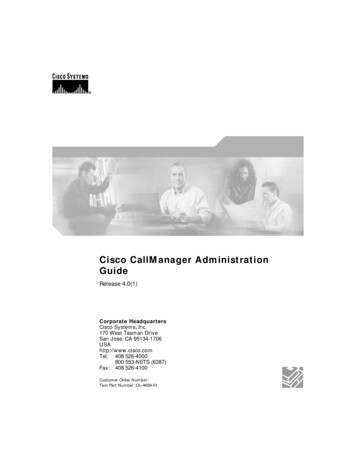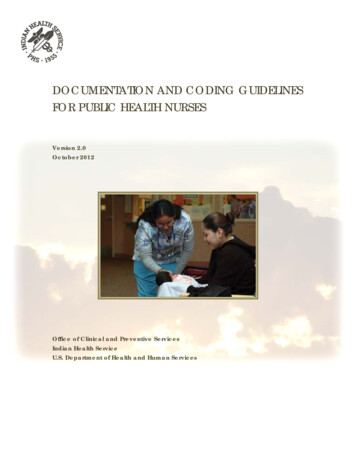
Transcription
DOCUMENTATION AND CODING GUIDELINESFOR PUBLIC HEALTH NURSESVersion 2.0October 2012Office of Clinical and Preventive ServicesIndian Health ServiceU.S. Department of Health and Human Services
ACKNOWLEDGMENTSThe IHS Office of Clinical and Preventive Services acknowledges the hard work ofthe following individuals who contributed, wrote, edited, designed, and distributedthe various versions of the Documentation and Coding Guidelines for Public HealthNurses: CAPT Tina Tah, Acting Senior Nurse Consultant for Public Health Nursing,Office of Clinical and Preventive Services, Indian Health Service; Dayle Knutson, Public Health Nurse Consultant, Aberdeen Area, IndianHealth Service; Susan Richards, Electronic Health Record Development Projects Director, Office of Information Technology, Indian Health Service; CDR Cheryl Peterson, Public Health Advisor (former senior nurse consultantfor public health nursing), Office of Clinical and Preventive Services, IndianHealth Service; CDR Wil Darwin Jr., Clinical Application Coordinator and Pharmacy Consultant, Albuquerque Area, Indian Health Service; Kennington Wall, Contractor, Office of Clinical and Preventive Services, Indian Health Service; Patricia Ramsey, Consultant, Office of Clinical and Preventive Services, Indian Health Service; Neva Kayaani, Public Health Nurse Consultant, Albuquerque Area, IndianHealth Service; and Angela Fallon, Public Health Nurse Consultant, Tucson Area, Indian HealthServiceii
FOREWORDThis manual was written by and for public health nurses in the Indian Health Service, in Tribal health facilities, and in Urban Indian health facilities.Users do not have to read this manual from start to finish. They can start at the beginning of any chapter and be able to understand the instructions. However, it isstrongly recommended that users read at least the first two chapters before movingon to anything else.The manual is configured in a modular format and can be printed on loose-leaf paper. When new content is produced, only the revised pages will be released. Userscan simply insert the new pages. The pagination of unchanged chapters will not beaffected.The chapter on the Electronic Health Record (EHR) is based on a training version ofthe EHR used by the Office of Information Technology in Albuquerque. The information displayed in the graphics is not actual data. Because the EHR is customizable, the way tabs and windows appear in EHRs in various facilities will differ.The use of acronyms is kept to a minimum.Most of the graphics are screen shots, and the low resolution of screen shots unfortunately contributes to a grainy look.If you have any comments, please contact Tina Tah at tina.tah@ihs.gov or at (301)443–0038.iii
TABLE OF CONTENTS1.0Standardized Documentation .1-11.1 Nursing Process as a Guide to Documentation . 1-1Refusals .1-81.2 Understanding the Data Collection Process . 1-8Electronic Health Record.1-9Patient Care Component .1-102.0Do’s and Don’ts of Public Health Nursing Documentation .2-12.1 Do’s . 2-12.2 Don’ts . 2-23.0 Setting up Public Health Nursing Clinics in the Resource and Patient ManagementSystem .3-13.1 Log onto the RPMS . 3-13.2 Navigate RPMS Menus. 3-33.3 Setting Up a Clinic, Starting With PHN PRINCIPAL . 3-14Default options .3-14Keyboard navigation.3-153.4 Review a Clinic After Setup. 3-213.5 Setting Up Public Health Nursing Clinics in the PIMS package . 3-24First Screen (See Figure 3.5a) .3-26Fourth Screen (See Figure 3.5b) . 3-264.0Using the Electronic Health Record .4-14.1 Log-In. 4-14.4 Review/Cover Sheet . 4-94.5 Allergies . 4-104.6 Vitals and Other Measurements . 4-15Historical Measurements .4-164.7 Chief Complaint . 4-204.8 Patient Education, Health Factors, and Exams . 4-22Health Factors .4-22Personal Health .4-22Exams .4-234.10 Purpose of Visit (POV) . 4-254.11 Visit Services . 4-284.12 Notes . 4-30iv
4.13 Medications . 4-344.14 Labs. 4-384.15 Radiology. 4-424.16 Reports . 4-444.17 Consults . 4-454.18 Quitting the Patient Record. 4-484.19 Help. 4-494.20 Refreshing Data on the Screen . 4-505.0Standing Order Documentation .5-15.1 What Is a PHN Medical Standing Order? . 5-1Example of an Individual, Patient-Specific Standing Order .5-1Example of a Non-Patient-Specific Standing Order .5-25.2 Verify Order . 5-35.3 Labs, Radiology, Consults, and Referrals Standing Order Entry . 5-4Select Patient and Visit, and Set the Visit Context to Indicate the Ordering MedicalProvider .5-4Document the Review and Update of Allergies and Adverse Reactions .5-4Document the Chief Complaint .5-9Document the Purpose of Visit .5-9Document the Activity Time. 5-10Enter the Lab Order .5-10Point-of-Care Laboratory Testing Standing Order Documentation . 5-12Authentication of an Implemented Order . 5-13Example of an Encounter .5-145.4 Medication Standing Orders. 5-16Sample Note .5-16Authentication of an Implemented Standing Order. 5-185.5 Immunization Standing Order . 5-20Immunization Documentation Example #1. 5-20Resulting Note .5-21Immunization Documentation Example #2. 5-22Resulting Note .5-23Authentication of an Implemented Immunization Standing Order . 5-235.6 PHN Referrals . 5-24Recommended Steps for Referred Care . 5-24Documentation of Referred Care . 5-24Authentication of Referred Care . 5-255.7 Other PHN Visits. 5-26v
5.8 Resources . 5-266.0Using the Public Health Nursing PCC Encounter Record .6-16.1 Date and Time . 6-16.2 Location of Encounter . 6-16.3 Activity and Travel Time . 6-26.4 Clinic . 6-2Most Common Clinic Codes for Public Health Nurses .6-26.5 Provider Codes . 6-4Affiliation .6-4Discipline .6-56.6 Measurements . 6-56.7 Purpose of Visit . 6-56.8 Medications/Interventions . 6-76.9 Patient Education . 6-76.10 Immunizations . 6-87.0Common Purpose-of-Visit Codes Used by Public Health Nurses .7-17.1 Prenatal (First, Second, or Third Trimester).7-17.2 Postpartum .7-17.3 Family Planning .7-17.4 Newborn.7-17.5 Chronic Illness and Care .7-17.6 Immunizations .7-27.7 Adolescent .7-37.8 Women’s Health .7-37.9 Screenings.7-37.10 Elder Care or Other .7-37.11 Acute .7-37.12 Follow-up .7-47.13 Diabetes mellitus .7-47.14 Communicable Disease .7-47.15 History of Hazards to Health .7-57.16 Problems With Lifestyle .7-57.17 Behavioral/Family Health .7-57.18 Case Management .7-67.19 Administrative and Counseling .7-68.0Priority, Intensity, and Timeliness for Caseload Management .8-18.1 Priority One . 8-1Initial Contact .8-1vi
Intensity of Visits .8-18.2 Priority Two . 8-3Initial Contact .8-3Intensity of Visits .8-38.3 Priority Three . 8-4Initial Visit .8-4Intensity of Visits .8-49.0Levels of Intervention.9-19.1 Primary Prevention: Prevention of Disease. 9-19.2 Secondary Prevention: Prevention of Complications With Existing Disease . 9-19.3 Tertiary Prevention: Improving the Quality of Life . 9-1vii
Documentation and Coding Guidelines for Public Health Nurses1.0 STANDARDIZED DOCUMENTATIONThis manual standardizes the documentation and coding practices of public healthnursing services for the Indian health system. Standardized documentation and coding improves (a) the accurate documentation of the care provided, (b) data generation and capture, and (c) comparability between programs and areas. It also helpsprotect the health system against liability.1.1 Nursing Process as a Guide to DocumentationPublic health nursing (PHN) documentation is part of a client’s medical record(which is a legal document). Nurses must make a record (either electronically or onhard copy) of every significant, patient-focused service. The documentation mustmeet certain criteria to comply with legal and accreditation requirements, as well aslocal bylaws, rules, and regulations. PHN-significant, patient-focused service includes all workload encountered by the program, such as the services listed in Table1.1.1.Public health nurses need to be aware that the same event can have two differentnames in the Resource and Patient Management System (RPMS) and the ElectronicHealth Record (EHR). For example, a clinic name in RPMS is called a visit locationin EHR. Notice the terms in the column headers in Table 1.1.1.The RPMS clinic name and the EHR visit location are not to be confused with location of encounter. Location of encounter designates exactly where the patient services were provided and needs to be documented in the nurse’s note to be entered inby data entry personnel.Table 1.1.1 Typical Public Health Nursing ServicesClinic Name (RPMS)and Visit Location(EHR)PHN Clinic (Encounter)DefinitionA patient had an encounter with a publichealth nurse or a public health technicianonly. No other medical providers gavecare. While RPMS refers to this as a PHNclinic, it does not mean that the encountertakes place only in an office or clinic setting.ClinicCodeandLocationCodeService Category(RPMS) and Type ofVisit (EHR)45AmbulatoryPage 1-1
Documentation and Coding Guidelines for Public Health NursesClinic Name (RPMS)and Visit rvice Category(RPMS) and Type ofVisit (EHR)PHN Visit to InpatientThe nurse had an encounter with a patientwhile the patient was located in inpatientward. Examples include a lactation consultation for new mother or referral from aprovider.45InpatientPHN Home VisitThe nurse provided health care service toa patient in the patient’s home.11AmbulatoryPHN Home Not FoundThe nurse attempted to provide healthcare service at the patient’s home, but thepatient was not home.11Not FoundPHN ImmunizationAn organized clinic (such as a flu clinic)provided assessment and administration ofimmunizations.12AmbulatoryPHN SchoolAn organized clinic at a school providednursing, education, or counseling servicesto school-age children (kindergartenthrough 12th grade). Do not use this codefor an immunization clinic at a school; seeabove.22AmbulatoryPHN HomelessThe nurse provided services to a patientliving in a homeless shelter, in transitionalhousing, on the streets, or with friends orrelatives.D3AmbulatoryPHN Homeless NotFoundThe nurse attempted to provide service toa homeless patient (defined above), butthe patient was not found.D3Not FoundPHN TelephoneThe nurse contacted an individual via telephone for a significant, health-relatedintervention. This includes contact by textmessaging.51TelecommunicationPHN Phone Not FoundThe nurse unsuccessfully attempted tocontact an individual via telephone or textmessage for a significant, health-relatedintervention.51Not FoundPHN Chart ReviewThe nurse’s review of the medical recordresulted in the documentation of medically significant information. This code doesnot include a patient visit.52Chart ReviewPage 1-2
Documentation and Coding Guidelines for Public Health NursesClinic Name (RPMS)and Visit rvice Category(RPMS) and Type ofVisit (EHR)PHN LetterThe nurse or technician sent correspondence to a patient to notify for immunizations due, to reschedule an appointment,to provide test results, or to schedule afollow-up visit.53Chart ReviewPHN Education ClassA scheduled, organized activity providedan education class to a group on healthrelated topics.60AmbulatoryPHN Case ManagementThe nurse made sure that the most appropriate type and level of care was providedin the most cost-effective manner to apatient in person.77AmbulatoryPHN Case ManagementThe nurse made sure that the most appropriate type and level of care was providedin the most cost-effective manner to apatient over the phone.77TelecommunicationPHN Case ManagementThe nurse made sure that the most appropriate type and level of care was providedin the most cost-effective manner in a patient’s absence.77Chart ReviewPHN Well ChildAn organized clinic provided developmental screening assessment and services towell children. This code is used in the fieldwhen a public health nurse works with apediatrician. Public Health Nurses usuallydo not work in well child clinics in the hospital or clinic.24AmbulatoryPHN OtherThis code is used only when there is absolutely no other code to describe a nurse’sintervention.25AmbulatoryThe Indian Health Manual (in Part 3, Chapter 3) states, “Timely entries must bemade on appropriate documents following examination and treatment as specified inIHS and facility policies.” (See http://www.ihs.gov/IHM/index.cfm?module dsp ihm pc p3c3.) Documentation must be accurate, relevant, timely, and complete.The scope of documentation must be organized, complete, and comprehensiveenough to provide continuity of care, to reflect all treatment, to support the healthcare provider’s reported workload, and to support services that are reimbursed bythird-party payers. Each patient event must include, or refer to, the: chief complaintPage 1-3
Documentation and Coding Guidelines for Public Health Nursesor reason for visit; relevant history and examination of findings; clinical impressionor diagnosis; plan of care; identification of appropriate risk factors; date; and legibleidentification of the health care professional.The Manual references time frames: “Each entry in the record is completed (including authentication) within the time frames delineated by the facility’s medical staffbylaws, rules, and regulations.” Public health nurses need to be knowledgeable of,and adhere to, their local facilities’ policies regarding time frames.Documentation has to occur in a timely fashion, usually at the end of the workday.In some cases, public health nurses deliver service in the field and do not return tothe office until the next business day; in these cases, documentation must happenwithin 24 business hours of the service delivered. Delaying documentation leads toincomplete or inaccurate information.In addition to incomplete reporting, delayed documentation can create a gap in service and possible harm to a patient. For example, let’s say a patient receives serviceon Monday from a public health nurse who does not document the service on the dayit occurred. Then, on Tuesday, an emergency happens and a different provider givesservice to the same patient without knowing what was provided on Monday becauseMonday’s service was not recorded yet in the patient’s record. This delayed documentation creates a health risk for the patient and a potential legal liability for theIndian Health Service if the patient experiences a negative outcome. Another negative scenario would be that medications or tests ordered for a patient are not delivered or performed in a timely manner because documentation was not made on theday of service. This would also create a potential health risk and legal liability.In regards to billing for PHN services, timeliness of documentation is crucial to support the processing of collection and to seek immediate reimbursement payments.Documentation must be accurate to avoid inappropriate billing practices and the potential for negative financial legal consequences, such as a facility having to repayfees. Therefore, every effort must be made to ensure that PHN documentation is accurate and timely.Remember: if a service was not documented, then the overwhelming presumption is that the service was not provided.The American Nurses Association’s Nursing: Scope and Standards of Practice provides nurses, regardless of specialty, with a scientific process in providing nursingcare. Using the nursing process as a tool in documenting patient care aligns with theIndian Health Service’s Health Information Management guidelines and is a bestpractice for managing documentation risk.Page 1-4
Documentation and Coding Guidelines for Public Health NursesAs public health nurses think about documentation using the nursing process as aguide, they must consider the subjective-objective-assessment-plan format (SOAP)outlined in Indian Health Service policy quoted below.Indian Health ManualPart 3: Professional ServicesChapter 3: Health Information Management 3–3.2 Health Record D. Electronic Health Records. Electronic capture and storage of patienthealth information will be implemented to enhance access to patient data byhealth care practitioners and other authorized users. Electronically storedand/or printed health information is subject to the same medical and legalrequirements as handwritten information in the health record. 3–3.8 Health Record Documentation AQ. Progress Notes. IHS adopted the Problem-Oriented Record System;therefore, notes should be written in the subjective, objective, assessment,and plan (SOAP) format. The progress notes must document the patient’scourse and response to treatment. The frequency of the physician’s or otherlicensed independent practitioner’s progress notes is determined by thechange in the patient’s condition, but must be adequate to document the severity of illness and the intensity of service during the patient’s hospitalization. Chapter 4: Nursing 3–4.5 Nursing Practice ManagementPage 1-5
Documentation and Coding Guidelines for Public Health Nurses E. Nursing Process. The nursing process (assessment, diagnosis, planning,intervention, evaluation), the framework of nursing practice, shall be appliedand documented in all three areas of nursing practice: inpatient, ambulatoryand public health nursing.Figure 1.1 Public Health Nursing terventionsPHNOutcomePHNPlanningNursing assessment includes subjective and objective information. Subjective data isdata that the patient states significant to his or her current condition, according toPatricia A. Duclos-Miller, author of Managing Documentation Risk: A Guide forNurse Managers. Duclos-Miller writes, “[I]f the patient says something that can beused to demonstrate mental, behavioral, or cognitive status at the time of the assessment, [then] documentation of the conversation can be used to measure progressor decline over the course of treatment.”Objective data includes data that can be measured, such as vital signs and results oftests. Duclos-Miller writes, “The physical exam of the patients—which includes keyPage 1-6
Documentation and Coding Guidelines for Public Health Nursesassessment techniques, such as inspection, palpation, percussion, and auscultation—provides objective data about your patients’ health status.”The North American Nursing Diagnosis Association states:Nursing diagnosis is a clinical judgment about actual or potential individual,family, or community experiences or responses to health problems [and] lifeprocesses. A nursing diagnosis provides the basis for selection of nursing intervention to achieve outcomes for which the nurse has n/GlossaryofTerms.aspx)In the SOAP format, nursing diagnosis is part of nursing assessment, because thediagnosis shows how a nurse made his or her clinical decisions, according to DuclosMiller.Nursing planning is the phase where the nurse takes the information from the assessment and formulates a plan of care that identifies and prioritizes the nur
nursing services for the Indian health system. Standardized documentation and cod-ing improves (a) the accurate documentation of the care provided, (b) data genera-tion and capture, and (c) comparability between programs and areas. It also helps protect the health system against liability. 1.1 Nursing Process as a Guide to Documentation

